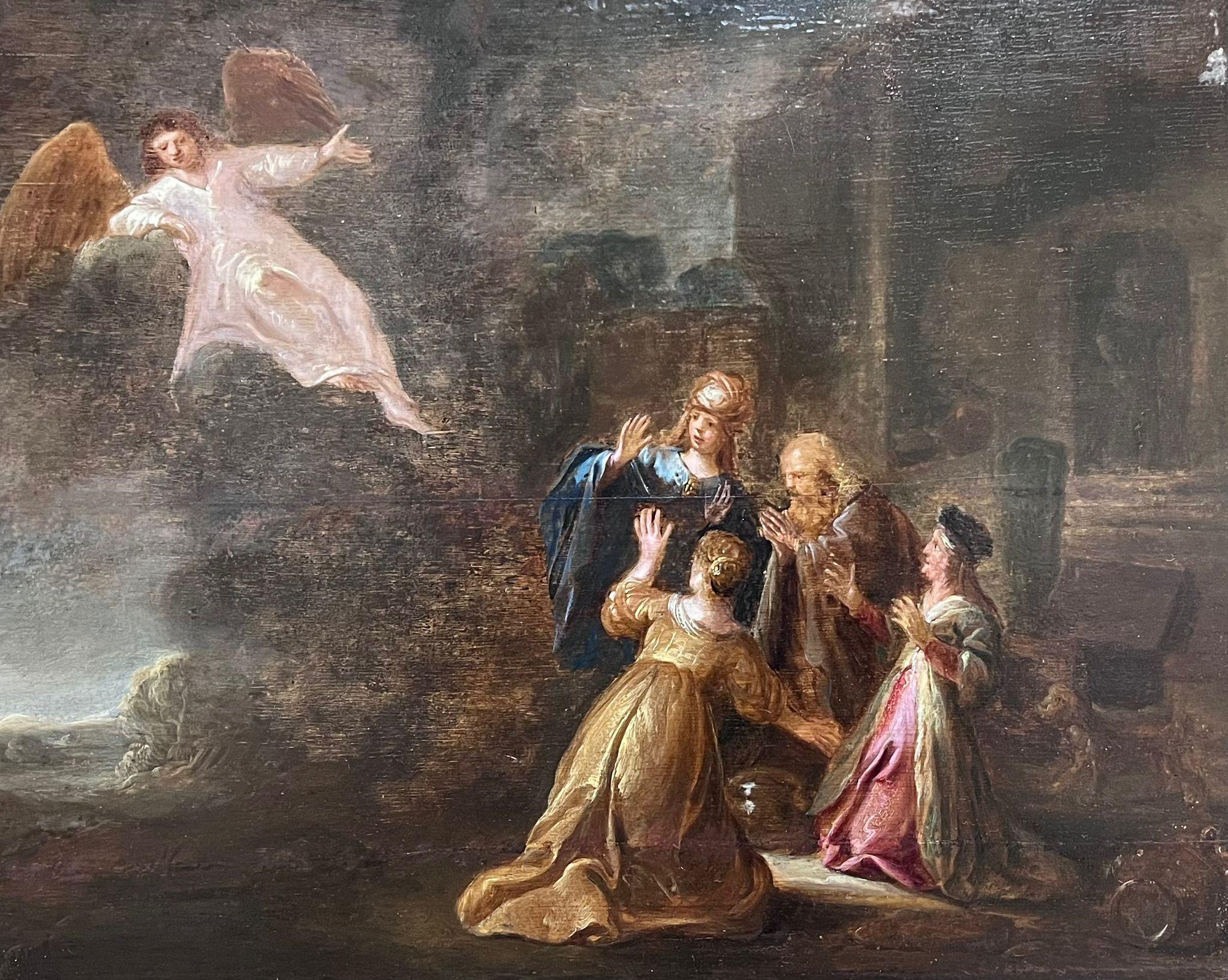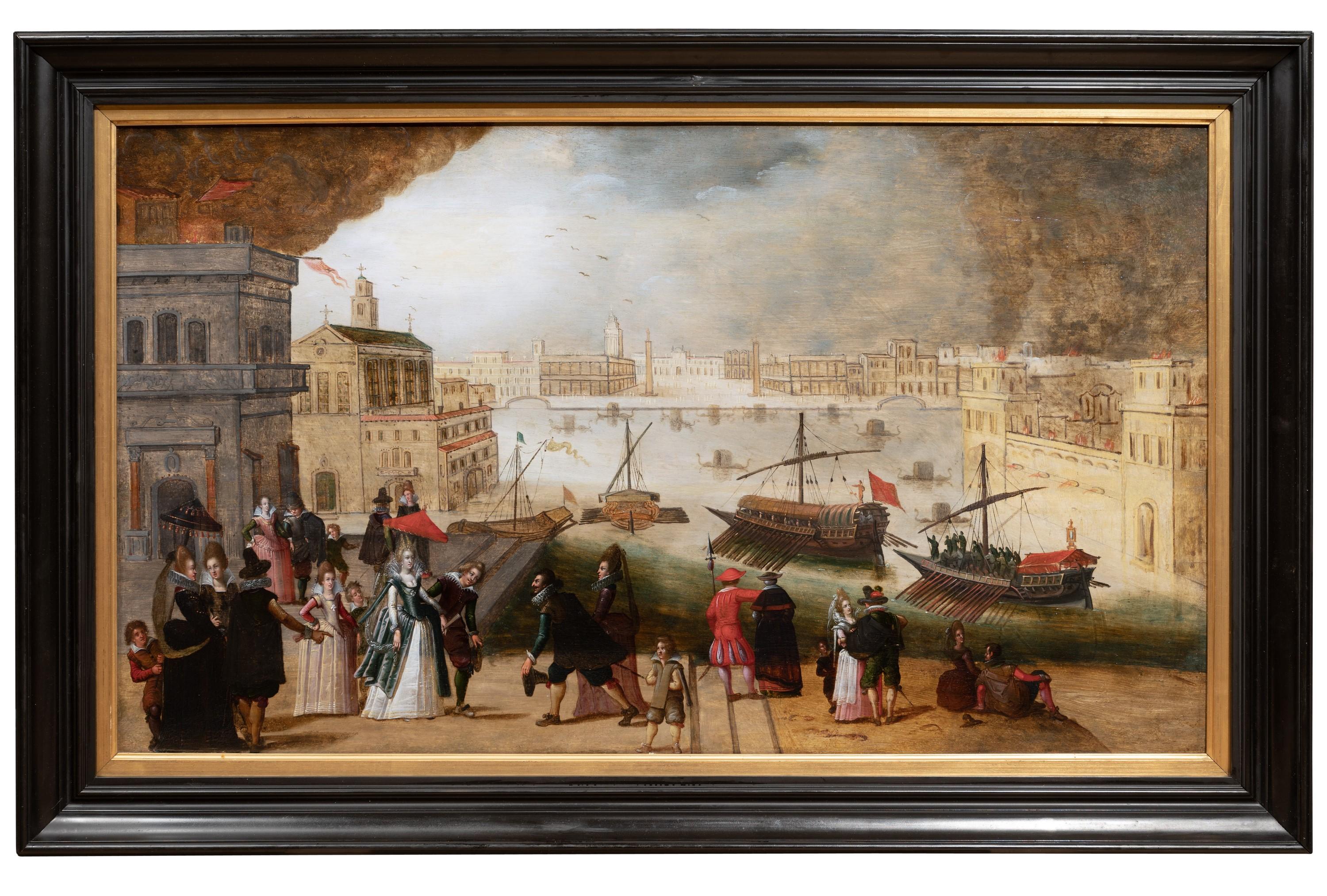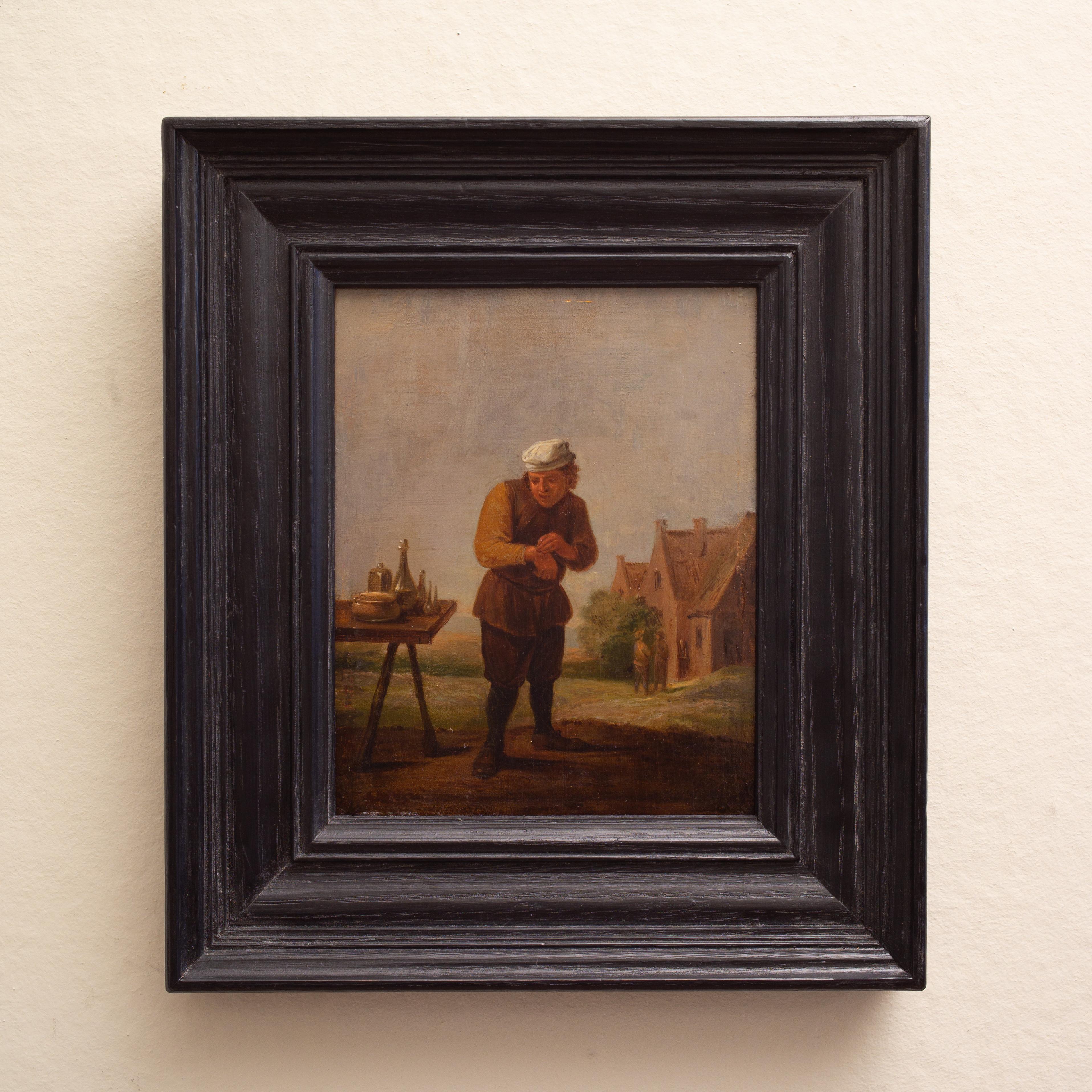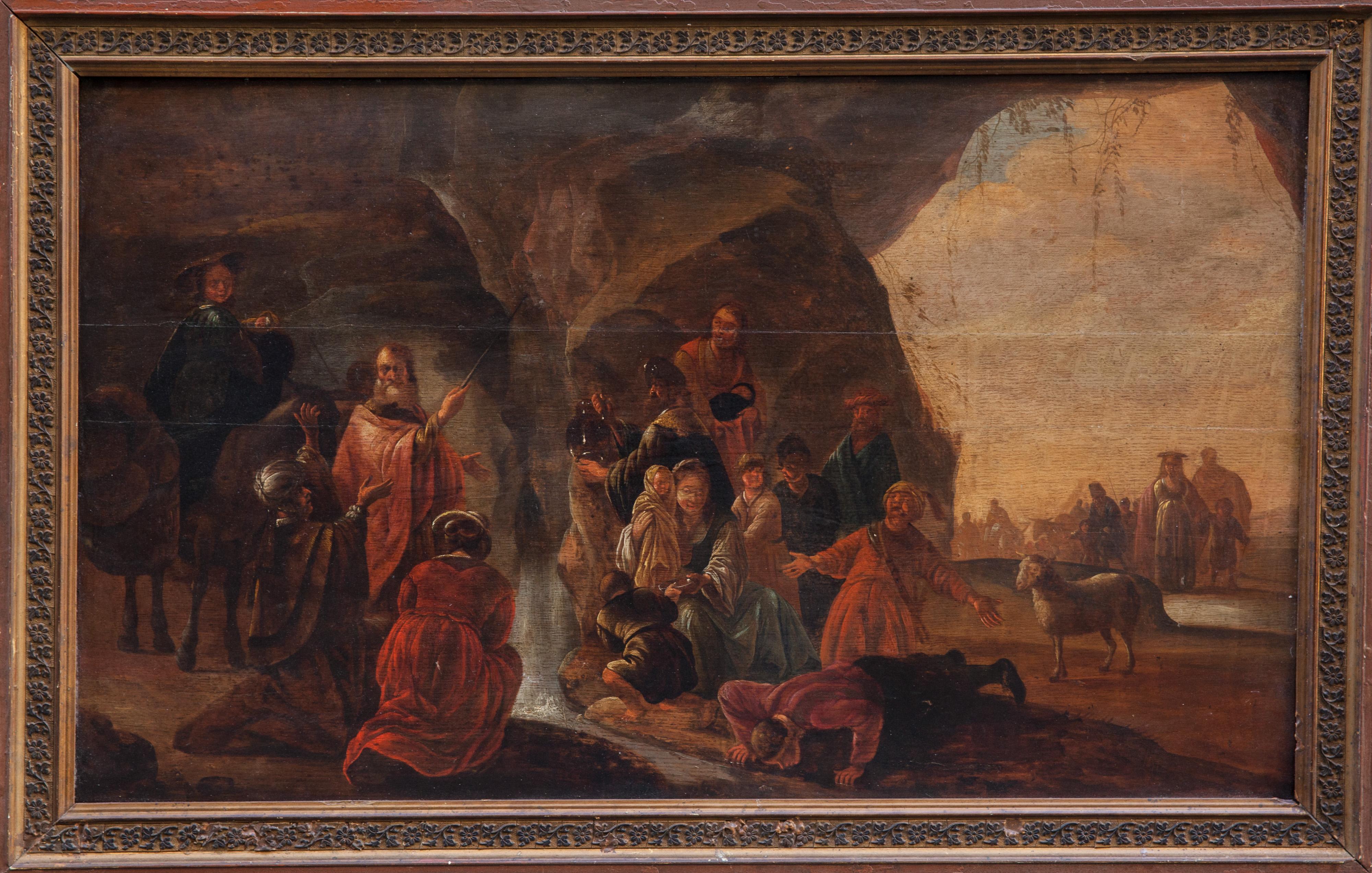Items Similar to Moses and the Pillar of Cloud by Lucas Cranach the Elder and Studio
Want more images or videos?
Request additional images or videos from the seller
1 of 11
Lucas Cranach the ElderMoses and the Pillar of Cloud by Lucas Cranach the Elder and StudioCirca 1530
Circa 1530
About the Item
Lucas Cranach the Elder and Studio
1472-1553 German
Moses and the Pillar of Cloud
Oil on panel
Moses and the Pillar of Cloud is a bold and evocative composition that showcases the signature intense color and intricate detail of Lucas Cranach the Elder’s celebrated oeuvre. The remarkable 16th-century oil on panel by Lucas Cranach and his studio captures the narrative moment when Moses leads the Israelites out of Egypt and encounters God manifested through a large pillar of cloud. Moses stands at the precipice of a bridge and turns back to soldiers helping to lead the group of Israelites who huddle closely together. Cranach depicts Moses with his traditional iconography, rendering the rays of light on his head which came to be interpreted as "horns" in the translation of the Bible. Using his traditional walking staff, Moses gestures toward the pillar, seemingly acknowledging that God will protect the group as they cross the bridge to the other side, leaving exile and entering a promised land.
In a nod to Cranach’s Germanic locale, he renders the figures and setting in a manner that feels decisively more akin to European aesthetics than those of the Red Sea. Soldiers wear elaborate, gothic suits of armor that recall the livery of Northern European guardsmen. The terrain appears more like a European forest giving way to a sweeping valley than the arid landscape the Israelites trekked through on their journey across the Red Sea. Though still clearly recounting a story from the Old Testament, Cranach renders the cast of characters and setting in an earthly, familiar manner. This aesthetic shift speaks to Cranach’s own changing beliefs as he found himself at the center of the Protestant Reformation.
After first gaining recognition in 1505 as the official painter of Frederick the Wise, Cranach established a thriving painting and print studio in Wittenberg, Germany. Cranach was renowned for his court portraits and genre paintings and was also well known for his association with the famous protestant reformer Martin Luther, then under the protection of Frederick the Wise. As Wittenberg became a bastion of new religious thought, Cranach soon befriended Luther and played an active role in creating the printed materials that proliferated throughout the Reformation.
Cranach worked with his sons and many assistants in order to spread the ideas of the Reformation through his prints and artwork. The Protestant faith famously renounced what they deemed the over-the-top iconographies of the Catholic Church, and Cranach’s artwork toed the line of representing the narratives of the Bible without soliciting the worship of icons. Rather, Cranach’s works served as a narrative accompaniment to the scripture that visualized the word that the Protestants so ardently sought to privilege. Still, Cranach’s bright, luminous colors and exacting details created captivating compositions that enchanted 16th-century patrons and continue to make a lasting impression today., Cranach’s bright, luminous colors and exacting details created captivating compositions that enchanted 16th-century patrons and continue to make a lasting impression today. Lucas Cranach the Elder’s works can be seen at the Metropolitan Museum of Art in New York City, the Kimbell Museum of Art in Dallas, Texas, the Kunsthistorisches Museum in Vienna, the Kunst Museum in Winterthur, Switzerland, Thyssen-Bornemisza Museo Nacional in Madrid, the National Gallery in London and the Getty Museum in Southern California.
This work is accompanied by a handwritten letter from a Cranach expert, Dr. Dieter Koepplin certifying the merit and quality of the work. Koepplin writes, “I consider this painting with Moses and the Cloud Column to be a very lively, high-quality work from the workshop of Lucas Cranach the Elder, created around 1525-1530. The state of preservation is excellent.”
Circa 1530
Canvas: 8 1/2” high x 18 1/8” wide
Frame: 12 7/8” high by 22 1/5” wide
Provenance:
Count Hessenstein, Sweden
Art dealer H. Bukowskis, Stockholm, 7-8 May 1941
Private collection, Sweden
M.S. Rau, New Orleans
- Creator:Lucas Cranach the Elder (1472 - 1553, German)
- Creation Year:Circa 1530
- Dimensions:Height: 12.88 in (32.72 cm)Width: 22.5 in (57.15 cm)Depth: 2 in (5.08 cm)
- Medium:
- Movement & Style:
- Period:
- Condition:
- Gallery Location:New Orleans, LA
- Reference Number:
About the Seller
5.0
Vetted Seller
These experienced sellers undergo a comprehensive evaluation by our team of in-house experts.
Established in 1912
1stDibs seller since 2013
15 sales on 1stDibs
Typical response time: 4 hours
- ShippingRetrieving quote...Ships From: New Orleans, LA
- Return PolicyThis item cannot be returned.
More From This SellerView All
- The Adoration of the Magi by Joseph van BredaelLocated in New Orleans, LAJoseph van Bredael 1688-1739 Flemish The Adoration of the Magi Oil on copper Painted on copper and exhibiting an exquisite luminosity, this exceptional painting...Category
Late 17th Century Old Masters Figurative Paintings
MaterialsCopper
- TaroudantLocated in New Orleans, LASigned, inscribed and dated "R. Pinatel / Taroudant / 1926" (lower right) Oil on panel A stunning ode to the Moroccan landscape, this oil on panel was composed by the French Orientalist painter Raphaël Pinatel, whose lively works adeptly translated the romanticism of the East for a Western audience. The present work, which captures a market in Taroudant, a city in southeastern Morocco, exemplifies the artist’s distinctive approach as he brilliantly translates the energy and atmosphere of the desert city. Pinatel’s style is impressionistic in his brushwork and handling of light and atmosphere. In the present work, he brilliantly captures the effects of the direct desert sun...Category
Early 20th Century Impressionist Landscape Paintings
MaterialsPanel, Oil
- La Terrasse Devant La Mer By Jean Pierre CassigneulLocated in New Orleans, LAJean-Pierre Cassigneul b.1935 French La terrasse devant la mer (The Terrace by the Sea) Signed “Cassigneul” (lower left) Oil on canvas laid on panel This monumental, three-panele...Category
20th Century Post-Impressionist Figurative Paintings
MaterialsCanvas, Oil, Panel
- L’embarquement by Gaston La ToucheBy Gaston La ToucheLocated in New Orleans, LAGaston La Touche 1854 - 1913 French L’embarquement The Embarkment Signed "Gaston La Touche" (lower right) Oil on panel A fashionable group of merrymakers boards a rowboat at sundown in this oil on panel by renowned French painter Gaston La Touche. Softly lit and lushly detailed, the work represents the artist’s talent for capturing the gaiety of the Belle Époque. With its luminous coloring and feathery brushwork, this oil evokes the style and joie de vivre of the era rendered in La Touche’s distinctive, mature style. Fresh and airy, the work is a beautiful example of the artist’s skill at capturing the subtle qualities of light and color. Set against the plein air backdrop of a wooded pond awash in the soft glow of the golden hour, the scene reflects the influence of the Impressionists. The subject also recalls works by Manet, Monet and Renoir, who delighted in depictions of modern leisure among the expanding middle class. The scene is an informal one, and its unconventional cropping suggests that the viewer is invited to take a seat in the boat and join the group on their outing. Such relaxed, inviting scenes were remarkably popular among contemporary, modern audiences. However, La Touche's style is singular, possessing an element of fantasy and romance that set him apart from the Impressionists. Gaston La Touche was born in St. Cloud, outside of Paris, in 1854, and he showed a keen interest in art from a young age. At ten years old, he began taking private art instruction, which lasted until 1870, when his family was forced to flee to Normandy amid the Franco-Prussian War. This was the only formal art training La Touche would ever receive. Despite his lack of Academy training, he made his debut at the Paris Salon of 1875 with a sculptural medallion and etchings, and he exhibited his first painting at the Salon of 1881. Although he began his career painting dark-toned realist compositions, by 1890, his style had shifted to what would become his signature — a lighter, brighter, idealistic society world. The artist was associated with practically all of the most influential artists and thinkers of late 19th century France, including Édouard Manet, Edgar Degas, Émile Zola, who frequently met at the legendary Cafe de la Nouvelle Athenes to share their thoughts on modern society. In 1900, he was named a Chevalier of the Legion d'Honneur and an Officer in 1909. Additionally, he was well-decorated at the grand...Category
Late 19th Century Impressionist Figurative Paintings
MaterialsPanel, Oil
- Bali by A. E. HerrmannBy A. E. HerrmannLocated in New Orleans, LAA.E. Herrmann Active in the 1920s Dutch Bali Signed "A.E. Herrmann 1932" (in lower right hand corner) Oil on canvas This enchanting work by Dutch artist, A.E. Herrmann depicts an exotic scene in Bali. In this magnificent painting depicting four Balinese women packing baskets, a vivid background is painted so that it is vibrant with the tropical colors of Indonesia. The stunning melon-hued temple becomes a focus in the painting and evokes a serene and mesmerizing scene of a faraway land. Indonesia and in particular Bali and Java was an extremely important...Category
20th Century Figurative Paintings
MaterialsOil
- Dance of the NymphsBy Paul Desire TrouillebertLocated in New Orleans, LAThis lyrical landscape entitled Dance of the Nymphs was composed by the French Barbizon painter Paul Désiré Trouillebert. A joyful scene of nymphs dancing the morning fog, the work closely resembles an important work by the great Camille Corot, which is now housed at the Musée d'Orsay (Paris). Renowned for his unique individuality that toed the line between the traditional and modern, Corot and his landscapes helped pave the way for an entire generation of Impressionists who followed him. Trouillebert perfectly captures the poetic atmosphere of Corot’s groundbreaking works, while also imbuing this scene with a freshness and character that is all his own. Trouillebert's oil on canvas is exemplary of the tradition of historical painting. The work perfectly combines a realistic depiction of the natural world with a spirited romanticism as his idealized nymph figures frolic playfully beneath a crisp morning sky. As a whole, it is a lovely composition executed with a level of skill and artistry that proves Trouillebert's exceptional talent in the arts. Born in Paris in 1831, Paul Désiré Trouillebert was a student of the academic painters Ernest Hébert...Category
19th Century Academic Landscape Paintings
MaterialsCanvas, Oil
You May Also Like
- Fine 17th Century Dutch Old Master Oil on Panel Angelic Visitation to FiguresBy Rembrandt van RijnLocated in Cirencester, GloucestershireThe Angelic Visitation Dutch School, mid 17th century circle of Rembrandt (Dutch 1606-1669) oil on wooden panel, framed in faux tortoiseshell style frame. framed: 25 x 28.75 painting...Category
17th Century Old Masters Figurative Paintings
MaterialsOil, Wood Panel
- Ascension Day in Venice, Louis de Caullery (1582-1621), Flemish 17th centuryLocated in PARIS, FRAscension Day in Venice 17th century Antwerp School Attributed to Louis de Caullery (1582-1621) Oil on oak panel Dimensions: h. 19.68 in, w. 34.25 in Flemish style frame in ebonized ...Category
Early 17th Century Old Masters Landscape Paintings
MaterialsOil, Wood Panel
- A Peasant Removing a Plaster: The Sense of Touch. By a Follower of David TeniersBy David Teniers the YoungerLocated in Stockholm, SEDavid Teniers the Younger (1610-1690) Follower of A Peasant Removing a Plaster: The Sense of Touch signed T on the table oil on panel panel size 7,20 x 5,55 inches (18,3 x 14,4 cm)...Category
Early 18th Century Old Masters Figurative Paintings
MaterialsPanel, Oil
- Italian Landscape With Figures at a Waterfall by a Follower of Jan van HuysumBy Jan Van HuysumLocated in Stockholm, SEThere are so many details to fall in love with in this 18th-century painting depicting an Italianate landscape, for example, the delicately painted figures having a conversation and ...Category
Early 18th Century Old Masters Landscape Paintings
MaterialsWood Panel, Oil
- Dutch School, 17th Century, Shipping in a Stiff Breeze, a City BeyondLocated in Stockholm, SEWe are delighted to present a significant piece from the Dutch School, most likely dating back to the late 17th century. This captivating painting showcases the dynamic force of nature with three ships vigorously navigating through stormy waters. The foreground is a scene of nautical struggle, as figures are depicted working intensely with the sails, steering, and bracing against the tumultuous sea. In the serene background, the silhouette of a quaint town emerges, with spires from churches and the outlines of various buildings is visible. This juxtaposition of the calm town against the chaotic foreground serves as a powerful reminder of the unpredictability of life and nature. Dominating the canvas, the sky occupies two-thirds of the painting, filled with brooding clouds that occasionally break to reveal patches of blue. The presence of birds adds a dynamic element to the otherwise ominous atmosphere. While the artist remains unknown, the work is quintessentially Dutch in its execution, with meticulous attention to detail and a profound understanding of maritime life. The painting's oval shape is quite distinctive and is complemented by a suitably antique octagonal black frame, which adds to its historical charm. This piece is a testament to the mastery of Dutch maritime painting...Category
17th Century Old Masters Landscape Paintings
MaterialsOak, Oil, Wood Panel
- Moses Strikes the Water from the Rock. XVII cent. Dutch school.Located in Firenze, ITMoses Strikes Water from the Rock Dutch school, XVII century. Workshop of Jacob de Wet (Haarlem, 1610-1675). Technique: Oil on oak wood panel, composed of 3 horizontal panels. In this evocative work, Moses stands in a cave, gathering the Israelites. There was no water to drink or for their cattle. The people were discontented in the desert. But Moses and Aaron listened to the voice of God. With Aaron’s staff, Moses struck the rock, and water gushed forth abundantly, quenching their thirst. Jacob de Wet’s workshop specializes in subjects from the Old and New Testaments. The recognizable rectangular format, simple compositions, and clear narratives define his style. The interplay of light and shadow, reminiscent of Rembrandt, adds timeless allure. The characters’ costumes, with their large hats and turbans...Category
17th Century Old Masters Figurative Paintings
MaterialsOil, Wood Panel
Recently Viewed
View AllMore Ways To Browse
The Antique
The Antique Collection
The Antique Gallery
Over The Sea
Painting The Letter
The Old Bridge
Under The Bridge
Studio Stockholm
Clouds And Sea
Antique Studio Light
Bible Used
The New York Collection For Stockholm
The Reform
Antique Cloud Painting
16th Century Oil
Large Oil Paintings Of Clouds
Large Pillars
The Decisive Moment





